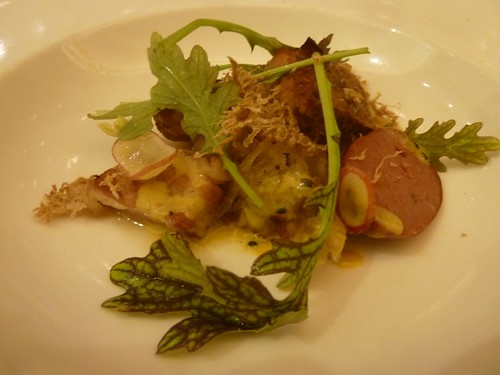
I’ve sometimes made reference to “Finedininglandia” or some other term representing the fact that wherever you are in the world, there’s a kind of international “country” of fine dining that transcends place. This is only natural because it’s a jet-connected world where chefs pop into each others’ restaurants around the globe, read the same books or articles about the same techniques, etc. So what one chef does in Oslo, soon becomes what chefs from San Diego to Sao Paolo are playing with. That doesn’t mean there’s no difference— obviously there is if there’s any sort of localism to the food— but nonetheless, as Walt sagely put it, it’s a small world.
I hadn’t really thought about the temporal rather than the spatial version of that that much, although it’s obviously the case— if everyone in 2012 is doing a certain thing, that means all restaurants are different even from themselves in 2008, say, when they were all doing a certain other thing. The reason I didn’t think about that, I’m sure, is that you can’t pop in to, say, Blackbird five or ten years ago and see how it’s different from Blackbird now. What’s the point of thinking about it if you can’t eat it? But I just wrote a review about a place (Urban Union) that I thought was kind of 2008 all over again, and if that sounds like a slam, I enjoyed revisiting 2008 again, having it to contrast with 2012. Some of how food has changed since then is more refined, but some of it is less focused than the simplicity of big porky flavor pops, which seemed to be all the rage then. So going back to 2008 was both instructive— and simply pleasurable.
I mentioned Blackbird because I went to a dinner there a couple of weeks, sponsored by Tasting Table (whose guest I was), that aimed to recreate the original Blackbird c. 1998-9 when it opened. Now that’s really going back in time— there are many restaurants still serving largely what they served then, I’m sure but Blackbird is one that has done so much to change the world it works in that its menu of 12 years ago is truly an act of historical reconstruction. Local produce is so much more common and available now, the idea of eating funky cuts is so much more common now (thanks in no small part to Blackbird famously popularizing pork belly and the like). But Blackbird has also changed, become more refined under Paul Kahan’s successive chefs de cuisine— more a citizen of Finedininglandia. (Listening to Paul Kahan talk that night about getting Blackbird open back in the day, you realize that apart from chic decor and location, it was kind of more like a hippie cafe in spirit than the typical fine dining of the day, with its emphasis on fairly straightforward ingredients rather than all the chic frou-frou of the time.)

Anyway, we had a three course meal of dishes from the early menu, including a sturgeon dish with spaetzle, housemade pickles and a buttermilk sauce, and a knackwurst and sauerkraut dish. Kind of amazing to think that a chic white restaurant then was serving hearty German food in the latter case, and in the former case, outright Jewish food. I knew Paul Kahan’s dad had had a fish smoking company, and deep down his connection to simple meaty ingredients came out of his growing up around the meatpacking district (he talks about that in my latest video) but never before had I had something at Blackbird that came so directly out of a Jewish fish merchant-and-deli milieu. And you know what? I loved it and I instantly wished that there was more of that on the menus of his empire. Why shouldn’t there be smoked fish at Publican Quality Meats next to chorizo and blood sausage? Paul Kahan’s the last guy who needs me or anybody to tell him what he should be cooking, but I’d love to have a Jewish Blackbird pop up some more, somewhere on the menus of his various places. In this case, seeing a little of Blackbird in 1999 opened the door to a whole world of Chicago food culture history beyond it.

* * *

I had another flash from the past at another meal. Sixteen is the restaurant in the Trump International Hotel & Tower. As you might expect, this is nosebleed-pricing fine dining land in every way, a very expensive menu, a grand dining room with a two-story sweeping wall behind it, a chef (Thomas Lents; I interviewed him here) who got his start at Everest but has worked all over the world for people like Joel Robuchon, and a pretty-much-admitted mission to land three Michelin stars, cost be damned. (I was a media guest. Needless to say.)
What’s interesting is that although it’s plainly modern food, it’s not modernist food— there’s only the slightest dabbling in foams, and no powders or other strange transformations happening here. Which makes me wonder— is there room in Michelin’s universe, and in that of diners for whom fine dining has come to mean Alinea’s and Next’s bag of magic tricks, for straightforward food at the highest level? Because this was, unquestionably, at the highest level, refined to a delicacy so exquisite that the only other place I’ve experienced anything like it lately was, indeed, during my sampling of the Next El Bulli menu. The difference is, when Next gave me a carrot dish that downright sang with the intensity of the purest carrot flavor, it was a space-age El Bulli concoction, disembodied carrot foam in a glass bubble. Where at Sixteen, Lents simply made carrot soup, physically as anyone might make carrot soup for a piece of Dover sole to sit in. (The sole was, incidentally, the one off thing of the night— tougher than it surely ought to have been, especially resting amid carrot evanescence.)
I have a menu and could list specific dishes but you know, they’re all composed plates consisting of several different tastes; it wouldn’t tell you that much to rattle them off. What I can say is that, at least eight times out of ten, they tasted intensely, almost fluorescently of themselves, the most radishy or gingery or black coddy a thing ever tasted. (The plates were also often fluorescently colorful as well, like the aftermath of an Easter Egg accident.) What it suggested to me is what Charlie Trotter’s must have been like 25 years ago. Not, I think, that Lents’ food is much like Trotter’s (though it might well be more like it than it’s like Alinea’s) but people who ate at Trotter’s back then felt that they tasted things, truly tasted them for the first time back then when he made them— surely as pivotal a moment in the making of our modern food scene as their first taste of pork belly at Blackbird. Without being like Trotter’s actual food necessarily, Lents’ food at its best was like tasting these things for the first time (even the one I’d just tasted for the other first time at Next). Lents is not exactly a locavore, though he is definitely buying things at peak season somewhere on the globe; for instance one vegetable, I forget which, was coming from Florida, from a farm next to where his parents live.
So if this is the Trotter of 2012, will that draw the crowds in 2012 without Alinea/Next conceptual pyrotechnics? I guess the Donald can gamble on that; so far Lents hasn’t gotten a lot of attention for what he’s doing, but maybe they’re just playing the long game and don’t feel the need to battle Nellcote and Balena to be restaurant of the moment. If you have the money— a big if— and are okay with the atmosphere of the vast hotel dining room (great view, leaves you feeling a little like the small fish in the very big tank), Lents is making gorgeous, exquisitely well-crafted food that deserves to be tried, even if only to know what a major hotel company’s best guess at what Michelin and its international audience of well-heeled diners will love looks and tastes like.
Tags: blackbird, sixteen

 Posted in
Posted in 




